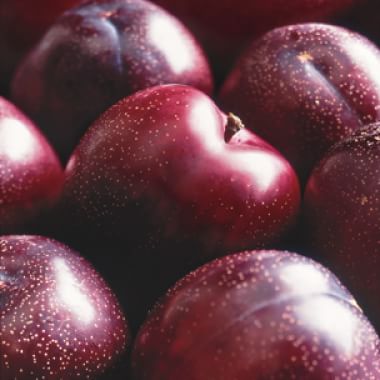
Take a trip to the farmers' market during plum season and you will find plums in colors that range from yellow and green to many shades of pink, purple and scarlet. In general, cooking plums are smaller and more acidic than the larger, juicier plum varieties. The latter are best used uncooked in tarts, shortcakes and other desserts and for eating out of hand.
Selecting
The first plums of the season ripen in mid-May, and fruits remain in the market through mid-September. To find a ripe plum, hold one in the palm of your hand. It should feel heavy and there should be some give, particularly at the blossom end. Tasting is the best indication of ripeness, so if you are shopping at a farmers' market, ask for a sample before you buy.
Storing
To soften hard plums, put them in a paper bag and let sit at room temperature for a couple of days. Because their sugars must develop on the tree, plums will not sweeten appreciably once they have been picked. Perfectly ripe plums can be refrigerated for 3 to 5 days.
Preparing
If you are using plum slices or halves in a pie or tart, leave the skins intact. They lend a pretty color to the finished dish. But if you are making a plum puree to flavor an ice cream or for jelly or jam, the skins will be unpleasantly acidic and should be removed. When plums are fully ripe, the skin should easily pull away, although it may need to be coaxed with a knife. If the plums are quite firm and the skin clings stubbornly to the fruit, slice a small X in the skin and blanch for 1 to 2 minutes in boiling water. The skins will then slip off easily.
Always taste plums before cooking. Tart varieties usually demand the addition of sugar, sometimes more than a recipe indicates. Balance the flavor of sweeter varieties with a squeeze of fresh lemon juice.
Adapted from Williams-Sonoma Kitchen Companion: The A to Z Guide to Everyday Cooking, Equipment and Ingredients (Time-Life Books, 2000)
Related Recipes:
- Grilled Chicken with Plum-Jalapeño Relish →
- Little Plum Galettes →
- Panna Cotta with Strawberries and Plums →
- Plum Buckle →
- Plum Crumble →
- Grilled Plums with Kirsch Cream →
- Plum and Goat Cheese Terrine with Gingersnap Crust →
- Plum-Almond Cake (Torta di Prugne e Mandorle) →
- Plum and Nectarine Sangria →
- Plum Butter →
- Cheese Blintzes →
- Plum Sorbet →












